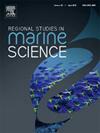Traceability of heavy metal contamination in surface sediments and sourcesink patterns in waters of the Miaodao Archipelago: Combined effects of natural factors and human activities
IF 2.4
4区 环境科学与生态学
Q3 ECOLOGY
引用次数: 0
Abstract
Archipelagos are unique marine units of ecological and economic value. Clarifying the source and sink patterns of heavy metals in archipelago sediments is crucial for pollution prevention. In this study, eight heavy metals ( As, Cd, Co, Cu, Hg, Ni, Pb and Zn) and their contamination levels were analyzed in 107 surface sediment samples from the marine waters of the Miaodao Archipelago. The sources and effects of the heavy metals were studied by integrating natural and anthropogenic factors, and their source-sink patterns were summarized. All analyzed heavy metals were present at low concentrations, with only light As contamination and a low single-factor ecological risk for Cd. Natural and anthropogenic sources accounted for 82.3 % and 17.7 % respectively. Shipping activities and aquaculture were the main anthropogenic sources of Co, Ni, Cu, Zn and Cd, and industrial and agricultural activities were the main anthropogenic sources of As and Pb. Yellow River pollutants, local aquaculture and shipping activities are the main contributors of metals in the sediments. The barrier effect of the archipelago coupled with natural factors led to the pooling of heavy metals, while human activities further enriched metal concentrations. The complex sedimentary dynamic environment and unique source-sink patterns of the archipelago greatly influence the distribution of metals. There is a need for enhanced monitoring and control of heavy metal contamination, especially As and Cd, in the region.
苗岛海域表层沉积物重金属污染溯源与源链模式:自然因素与人类活动的综合影响
群岛是具有生态和经济价值的独特海洋单元。厘清群岛沉积物中重金属的源汇模式对污染防治至关重要。本研究分析了苗岛群岛海域107份表层沉积物样品中As、Cd、Co、Cu、Hg、Ni、Pb和Zn 8种重金属及其污染水平。综合考虑自然因素和人为因素,研究了大气中重金属的来源和影响,总结了其源汇模式。所有分析的重金属浓度均较低,仅存在轻度砷污染,镉的单因素生态风险较低。自然和人为来源分别占82.3 %和17.7 %。航运活动和水产养殖是Co、Ni、Cu、Zn和Cd的主要人为来源,工业和农业活动是As和Pb的主要人为来源。黄河污染物、当地水产养殖和航运活动是沉积物中金属的主要来源。群岛的屏障效应和自然因素导致重金属聚集,而人类活动进一步富集了重金属浓度。群岛复杂的沉积动力环境和独特的源汇模式对金属的分布有很大影响。有必要加强对该区域重金属污染,特别是砷和镉污染的监测和控制。
本文章由计算机程序翻译,如有差异,请以英文原文为准。
求助全文
约1分钟内获得全文
求助全文
来源期刊

Regional Studies in Marine Science
Agricultural and Biological Sciences-Ecology, Evolution, Behavior and Systematics
CiteScore
3.90
自引率
4.80%
发文量
336
审稿时长
69 days
期刊介绍:
REGIONAL STUDIES IN MARINE SCIENCE will publish scientifically sound papers on regional aspects of maritime and marine resources in estuaries, coastal zones, continental shelf, the seas and oceans.
 求助内容:
求助内容: 应助结果提醒方式:
应助结果提醒方式:


